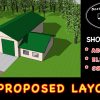This is the last of a 5 part series which outlines every step from repairing different types of fiberglass damage, thru the priming, painting and applying Awlgrip nonskid for a newly refinished deck! If you haven’t seen the previous episodes CHECK THEM OUT! They are posted on the home page of this site!
Particulars about the different coats of paint in this video:
~ When rolling out the smooth coats of paint with the flattening agent, I used the slow reducer (T0031) to allow for more work time before the surface skinned over. These coats were mixed in equal amounts (paint, converter, reducer and flattening agent (1:1:1:1) and were rolled and tipped. Using less flattening agent will product a finish with more gloss. For example cutting the amount of flattening agent in the mix by half will result in a satin finish, however for a flooring project I felt this was still a little too glossy. After deciding to go with a true FLAT finish I used the proportions outlined above and was very happy with the results!
~ When rolling over the nonskid particles (GripTex) for the final coat, I used the same proportions of paint, reducer, converter and flattening agent BUT used the FAST evaporating thinner (T0002)! The reason being that this coat was going to be a much thicker film and I wanted the solvents to gas out of the paint as quickly as possible to avoid what is called Solvent Pop (AKA blisters in the paint). This is a result of the paint skinning over before the solvents have had a chance to evaporate out of the paint; essentially getting trapped. Over time the solvents will continue to try and escape, and to an extent they will succeed but the result will be blistering 🙁
Please ‘Like’ or ‘Share’ above and join the discussion below in our comments section!!
Also, please remember that there are extended ad-free versions of these video’s available for Patreon supporters! Please click below to find out more.
Materials, Tools, & Suppliers
- Awlcat #3 Brush Converter
- Awlgrip Flattening Agent
- Awlgrip GripTex
- Awlgrip Paint
- AwlPrep Plus Wax
- Chip Brushes
- Mohair Roller
- Stir Sticks & Mixing Cups
- T0002 Reducer
- T0031 Reducer










Andy,
Love your site! Gteat information! Thanks for taking the time to explain fiberglass repairs complete to finish work. I unfortunatly have a addiction to working on my boats. In the process of redoing a 1977, 20′ Wellcraft step V again!, 16′ skiff for the third time and the big project 1968 Chris Craft 31 Commander. I am interested in using Sherwin Williams 2 part polyurethane industrial/marine paint mainly because of the cost, custom color range and wanted your opinion. Not necessarily the brand but 2 part polyurethane paint. Also after reading Awlgrips application guide (several times) wondering if this might be an easier process.
Thanks,
Del
Hey Del,
Thank you! Wow, sound like you have your hands full with projects :-O Pretty much all the 2 part poly paints I’ve come across are pretty decent. I’ve never used any of the sherwin williams stuff, but may be tempted to give it a try on some test pieces and do a compare / contrast with the more common brands (awlgrip, interlux, ppg, etc). I would check to make sure it’s a buffable paint. If so and the price is right give it a shot! At least on some test pieces before doing the entire boat 🙂 Let me know how it goes!
For what it’s worth, reading the awlgrip manual can be a little confusing. It’s very technical and in my opinion the wording over complicates what is actually a simple process. I’m very familiar with their products so if you have any Q’s please let me know..
Good luck
~Andy
Andy,
You asked me to post some pics of my project(2001 Maxum 2300). Here is what I’m working with. Basically three areas of concern. 1) Surface cracking of the dash. 2) Stress cracks emanating from the deck hardware and windshield screws(of which some are stripped) 3) Localized stress cracks on the bow which looks like it was from an impact.
So the plan is to remove the windshield and deck hardware, grind down the dash cracks to good fiberglass, grind out the stress cracks, fill and redrill the windshield screw holes, fill/fair/repaint the dash(epoxy topside paint?), and fill the gelcoat cracks. Any tips or product suggestions? Thanks again and great videos!!
http://share.shutterfly.com/action/welcome?sid=0ActmLZq4YuGjmI
Also, I just saw the pictures of the Bayliner dash you did. That’s exactly what I need to do!
Jerry, I just looked over the pics you posted; it’s an almost identical project to what I did on the Bayliner! I can easily walk you through the process 🙂 Depending on when you are looking to start the repairs I am going to be doing a detailed series on gelcoat for the month of November (4 vids covering everything from color matching, mixing, application, and finishing). Given your project I may even throw in how to make a mold of the gelcoat non-skid so you can fix that as well!!
One quick question about that Bayliner. What type of paint did you use? I’m looking at doing all of the repair work with West System epoxy resin and painting over with Pettit Easypoxy (after a full cure of the resin). Does that sound reasonable?
On the Bayliner that I did I actually used gelcoat for the topcoat. All the repairs were done with poly resin and 1.5oz CSM with a gelcoat or polyester based “cover coat” to fill pinholes, imperfections, etc and the topcoat was sprayed with color matched gelcoat (wetsanded and polished). If you’re looking to use gelcoat as the top surface it would probably be best to use poly resin with the glass repairs, then gelcoat for the top. If you’re going to paint, then epoxy would be fine.. It really depends on what you prefer to use for the finished surface….
Easypoxy probably would not be the best choice as it is a “soft” paint meaning that it will be prone to dulling and scratches. When I paint I use Awlgrip which is a 2-part paint (much harder and more resistant to UV exposure, chemicals, wear and tear, etc)..
Ok, I think you talked me out of the Easypoxy. I am now looking at the two-part Epifanes poly-urethane. The dash will be a total redo so no color matching issues, but I’m worried about blending the paint into the gelcoat on the topside deck repairs. The Maxum has an off-white gelcoat. Epifanes has a few shades of white, so hopefully one will match.
One other option to look into would be to contact Spectrum Color to see if they have the factory color matched gelcoat avail for your boat. For something like this gelcoat would really be the best thing to use 🙂 Blending the new onto the old surface would be much easier and it will provide a little more wear and tear as it is a much thicker film (scratches, etc). Let me know if you have any further Q’s!!
Again, thanks for the great advice. I contacted Spectrum and they carry the stock gelcoat color in a repair paste and liquid. So, it looks like I’ll probably use the gelcoat on the deck repair spots and only use the two-part poly on the dash. Have you ever used a PreVal sprayer to shoot small areas of gelcoat?
Yes I have but only for small areas (less than a square foot). In a pinch they work OK, but if there are a number of areas it may actually be a better idea to buy a cheap spray gun (home depot or harbor freight) providing you have a small air compressor. I think you can pick one up for around $30 or so and you’ll get a much better spray pattern (which means less sanding!) If you decide to go that route let me know and I’ll see if I can pick a few options for you 🙂
For small repairs what I tend to do more often times than not is simply brush the gelcoat on with a cheap disposable brush (for chips, scratches, etc). But it doesn’t work too well for larger areas. There tends to be more sanding when it’s brushed on, but the materials are cheap and it’s pretty simple.
Depending on when you’re looking to do these repairs I am going to be doing a detailed series of gelcoat videos’ this Winter that may be very helpful. If you’ll be tackling the work sooner rather than later don’t hesitate to contact me with any Q’s! What you’re looking to do isn’t very difficult but there is a process to have it turn out right 🙂
By the way, thank you for supporting the show! It really means a lot..
Talk to you soon,
Hope all is well.
~Andy
Great videos. I am painting a Boston whaler that has a textured floor. Any special advice. I am concerned that I may have to sand too much of the texture to be effective and get a good bond.
I have been giving some thought to my problem (see above). After watching your video again I am thinking of buying a new/clean scrubbing brush and scrubbing down with the Awlgrip wax/grease remover as a prep. I have filled many holes trying not to get any epoxy on the deck. There are a number of stains on the floor with I have not been able to remove. This seems as close as I can get to your example. Any thoughts
I will soon be using awl grip on the deck of a 44ft sailboat. I strongly favor a “flat” finish on the non-skid, but I’m very worried about it being harder to clean and holding stains more with the flat instead of gloss. I had this happen on a different “non-awlgrip” deck project and it was a nightmare to keep it clean. Do you have any opinions about that?
More than likely there wasn’t enough paint applied after the non-skid particles to fill the nooks / crannies around the granules leaving lots of little pockets for dirt to get stuck. I like to seal the particles twice; once with high gloss, and the last coat with the flattening agent to give a flat / semi gloss appearance. This should take care of any issues 🙂
Hi, your non-skid looks great. I wanted to pass along something the shop I help out at just did when applying non-skid to the deck of a new boat. After rolling and tipping the Awl-grip they sprayed Petit non-skid compound on with a detail sprayer. When I say sprayed the compound, I mean that was the only thing in the sprayer. The entire non-skid application process took about 20minutes for the deck of a 26 foot boat. It produced the most even non-skid I have seen. A top coat od thinned awlgrip finished the process.
Todd
Bass Harbor, ME
That does work well! I do that for large areas on deck, but tend to use the broadcast method around mechanical as I don’t want to worry about the grit getting into things it shouldn’t 😉
I really enjoyed your videos, great info. The fact you acknowledged your mistake with the roller cover
( which happens to all of us applicators ) made me appreciate your skill all the more. I will use your Amazon link to make purchases. Thanks, Jeff
Thanks Jeff!
Andy,
Using Awlgrip Griptex, Softsand or any non-skid addictive, have you ever applied them to gel coat? I have been looking all over for information and even the manufactures do not have real answers. I am going to spend all Winter making samples to see if I can find a formula if you do not know of anything. And yes, I can buy the forms and make my life easier expect 1 square foot of that stuff is like $80. I need to cover the entire 32′ boat and i do not have a $1000 to spend on a mold I will most likely use just once. So any information on making a non-skid surface using gel coat and that “sand”, would be helpful!
Thanks,
Ken
Hi ken! I haven’t tried it yet, but I know Soft Sand has been experimenting with it. I don’t see any reason why it wouldn’t work though. Roll of a heavy coat of gel, while it’s still wet sprinkle in the nonskid particles and allow to set up. Then go back over with a couple thin coats of gel to seal everything in.. Might have to play around with it this Winter!
This is a good site, and I’m hoping you can help me in painting my fiberglass deck. The boat is a 1961 Rhodes Ranger Sailboat that I painted 18 years ago. I’m using AwlGrip primer and topcoats with their non-skid granules thrown in.
My questions: (1): AwlGrip writes that scrubbing well with a mix of Ajax or Comet and water suffices for sanding. Is that actually ok?
(2): AwlGrip advises to cover the painted area overnight to prevent dew settling on the surfaces. If I finish painting by noon Chicago time, temps in the low 70s, can I just throw a painters’ tarp on the surface about 8:00 p.m.? Is it really necessary since gloss is not relevant for primer? What about for the topcoats?
Thanks!!!!
Jack Harkins